Review: Motorola Z Droid, Z Force Droid for Verizon Wireless
Jul 21, 2016, 8:00 AM by Eric M. Zeman
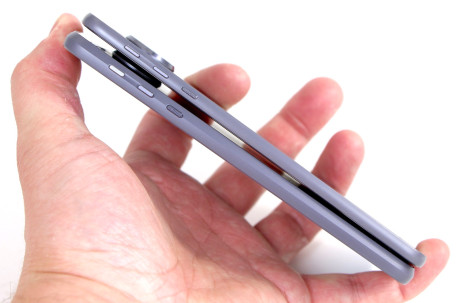
Motorola's flagship smartphones for 2016 are the Moto Z Droid and Moto Z Force Droid for Verizon Wireless. These Android smartphone are unique thanks to their slim, metal designs and swappable modular back panels. Here is Phonescoop's full review of these handsome handsets.
Is It Your Type
Motorola is back with another series of Droids for Verizon. The Moto Z Droid Edition and Moto Z Force Droid Edition are thin, light, and powerful smartphones that are unique thanks to their swappable rear accessories. For Verizon customers who prefer Android over iOS, the premium Droid series from Motorola is a compelling option to Samsung's Galaxy S7 and LG's G5 smartphones.
Body
The Moto Z and Z Force represent some of Motorola's finest thinking. These flagship smartphones include every possible feature and somehow manage to squeeze them into some of the thinnest handsets out there. Moreover, Motorola's ecosystem of swappable back plates — many adding unique functionality to the phones — is well conceived and executed.
The Z and Z Force are nearly identical. The Force has a tougher display and bigger battery, which makes the phone thicker and heavier. Other than the thickness, there is no outward or obvious difference between the two.
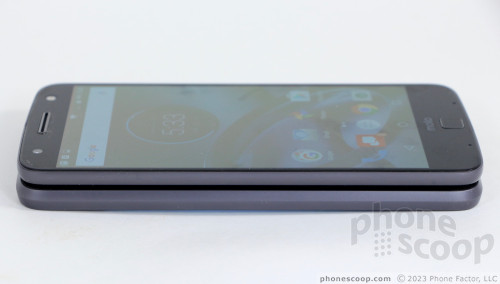
Made of metal and glass, the Zs look high tech. The face is 2.5D curved glass that's fitted precisely into a machined metal frame. The rear has glass and metal panels, and a series of copper-colored contacts. The absolutely huge camera module looks like a robot eye, staring at you. These phones scream modernity; they are cutting edge.
The Moto Z is about same size as last year's Moto X and many other big-screened phones. At 5.2mm thick, it's one of the slimmest smartphones around. Seriously, everyone I've seen hold one has expressed shock at how thin it is. The Z Force is a hair bigger at 7mm thick. The Moto Zs are two-handed phones and may not work for people with small hands. The Moto Z fits into most pockets quite easily. The Z Force is more noticeable when you carry it around, but only because it's heavier.
The materials, manufacturing, and quality are top notch. The frame hugs the front glass tightly, and the three major pieces of the rear panel (glass, metal, glass) are slotted together perfectly. The phones look and feel every bit the flagships they are. The Z and Z Force are on par with the excellent build of Samsung's Galaxy S7.
Motorola maximized the screen real estate on the front of the phone; bezels are at a minimum. A raised lip signals the location of the earpiece above the screen. The user-facing camera is off to the left, while the selfie flash is off to the right. It is easy to spot the square-shaped fingerprint reader below the screen. The Moto Zs don't use physical buttons and instead rely on in-screen controls for the Android operating system.
I really like the metal frame, which is smooth all the way around. All the buttons are on the right edge of the phone. The screen lock button is the first button your thumb encounters as is slides up the side. The button is small, but has a sharp, ribbed texture that make it easy to find. Travel and feedback are good. The volume controls have been separated into two buttons. These keys have a smooth texture to differentiate them from the lock screen button, but are about the same size/shape and deliver the same travel and feedback. When you're in a hurry, it is easy to mistake one for the other. The dual-purpose SIM card / memory card tray is tucked into the top edge.
Motorola is one of the first phone makers to drop the trusty 3.5mm headset jack completely. Instead, the Moto Zs have a single, all-purpose USB Type-C port for charging, data transfer, and music output. This is sure to be a dealbreaker for some. I have mixed feelings about it.
There's no arguing that USB-C is the future, but breaking with legacy technology introduces a host of inconveniences. You can't simply plug the Z into your stereo or car and expect it to just work. Motorola is including a 3.5mm adaptor dongle with the Moto Z, which means it will still work with most headphones and other accessories as long as you remember the dongle.
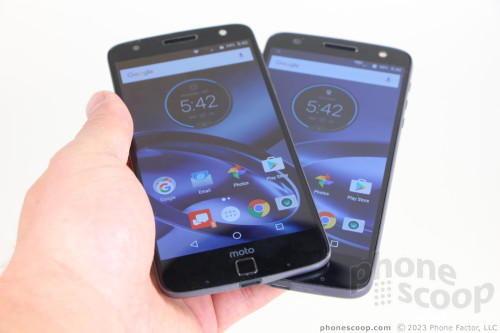
Motorola contends that more people are using Bluetooth headsets. That's certainly true in my case. I've fully moved from wired to wireless headphones, be they earbuds for exercising or over-the-ear cans for high quality listening. I've come to prioritize the convenience of no wires, despite the differences in audio quality. Bluetooth headsets have their own issues. For example, you need to remember to charge them, and you can't use them everywhere, such as on airplanes. Whatever side of the debate you fall on, the Moto Z and Z Force are looking forward, not backward.
The Moto Z's rear panel is certainly unique. Two things stand out: the camera and the contacts. The camera module is huge and juts out of the surface like a stack of quarters. A reflective rim calls your eyes to it. The "Droid" branding is crammed in between the lens and the two-tone LED flash tucked into the bottom of the circle.
Motorola's proprietary magnetic module connector is positioned near the bottom of the rear panel. There are two stacks of eight pins separated by a notch to help position the modules. A solid metal bar underlines the entire array. Motorola says it engineered the heck out of this magnetic system. Indeed, the magnets seem incredibly strong and robust.
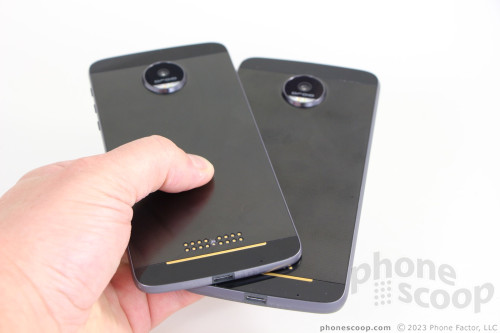
The metal panel between the camera and magnets has a barely-there ribbed texture. It's about the only thing I don't like about the phone's design. I'd prefer to see a solid paint job/texture.
Given the super-thin profile of the Z, it should go without saying that the rear panel cannot be removed and neither can the battery. That may be a dealbreaker for some.
Motorola did a bang-up job with the Moto Z and Z Force. The company has never designed more attractive, more appealing hardware.
Screen
The Moto Z and Z Force both feature 5.5-inch quad-HD screens (2,560 by 1,440 pixels). The Force model includes second-generation Shattershield "unbreakable" glass. Even so, the two displays look identical to my eyes in terms of brightness, resolution, and color. I studied them side-by-side intensely and concluded they are equal. The resolution is excellent and makes the Z series good for virtual reality applications. The brightness is excellent for indoor use, but just adequate for outdoor use. You need to boost the brightness all the way in order to see the screen under sunny skies. Color accuracy is quite good, as are viewing angles. I didn't see any brightness shift, nor color change when I tilted the phones back and forth. Bottom line: the Moto Z and Z Force have good screens.
Signal
These phones are signal champs. The Zs remained on Verizon's LTE network at all times; not once did they lose signal nor ever drop to 3G. The phones always maintained a solid connection to Big Red's network. I was able to make calls everywhere I took the Z and Z Force and the phones held calls at highway speeds easily. Data speeds were quite good when it came time to upload images to Instagram or download apps from the Play Store. The phones streamed high-quality YouTube videos and Spotify tracks without any hiccups.
Sound
Call quality is average. The Zs are decent phones for making calls, but far from the best. Earpiece volume is the biggest issue. I was able to hear calls in my home and office. But coffee shops, city streets, and other environments produced enough noise to drown out conversations. Clarity is not great, either. I noticed a bit of distortion that clouded conversations from time to time. People I spoke to through the Moto Z and Z Force said I sounded "far away."
The speakerphone offers a solution. The earpiece doubles as the speakerphone. When used as a traditional speakerphone (phone on a table/desk while you sit or stand nearby), the Z is acceptable. The speaker produces enough sound for convos in quiet spaces, but not loud spots. I found that using the speakerphone at a low volume while holding it directly to your ear presented the best solution when you really need to hear calls. Clarity via the speakerphone mirrors that of the earpiece.
The Z and Z Force include Verizon's Advanced Calling app, which delivers HD Voice over VoLTE. Call quality via HD Voice was far clearer than over Verizon's regular voice network, but HD Voice couldn't help improve the volume issue.
Ringers and alert tones could definitely be louder, but the vibrate alert always got my attention.
Battery
Motorola says both the Moto Z and Z Force offer more than a full day of battery life, and that's the truth. The Moto Z (with a 2,600 mAh battery) consistently got me from breakfast to bedtime with some power to spare. I had a hard time getting the Moto Z's battery down to 15%, let alone depleted completely. The Z Force (with a 3,000 mAh battery) pushed even further into a second day. Motorola has always prioritized battery life for its Droid handsets, and the proof is in the pudding. The battery life is so good, it almost makes me wonder why one of the Moto Mods is a battery pack.
The phone includes only the simply Android battery tool. This can be set to come on automatically, or switched on/off when needed. It reduces processor output, dims the screen, and cuts down notifications.
Both phones support rapid charging via the USB-C port. Motorola says 15 minutes of charging adds 8 hours of life to the Z and 15 hours of life to the Z Force. I can tell you that the phones top up very quickly.
Bluetooth, GPS, NFC, WiFi
With no 3.5mm headphone jack, the Bluetooth radio needs to perform flawlessly. It's a good thing, then, that the Moto Z and Z Force offer excellent Bluetooth functionality. Pairing with other devices via the system menu was easy enough, but I resorted to NFC-aided pairing whenever possible. I connected the Zs to speakers, headphones, PCs, and my car with little effort. Call quality was surprisingly good when pushed through a dedicated headset. Music sounded excellent through a pair of Bluetooth speakers I've been testing.
The NFC radio supports Bluetooth pairing, as noted, but also works with Android Pay for mobile payments.
Google Maps made excellent use of the Z's GPS radio. The phones found me in a blink and worked great as live navigation tools when driving from Point A to Point B.
WiFi performance was good.
Comments
Not cheap
(continues)
No headphone jack = non starter
They already have to have a bulge near the top of the phone for the camera, why not extend that enough to have the headphone jack?
Give me a phone that is 1/3 thicker for 2x the battery life anytime. Too much vanity over functionality!
Very nice but...
But what I'd really like, is a smaller version of this phone. This size is simply way too large for most people! Why not offer a 5.0" (or better a 4.6") screen size with 1080p screen for smaller hands. I'm sure they will have a winner as many people will go for it.
Think about it, Moto!


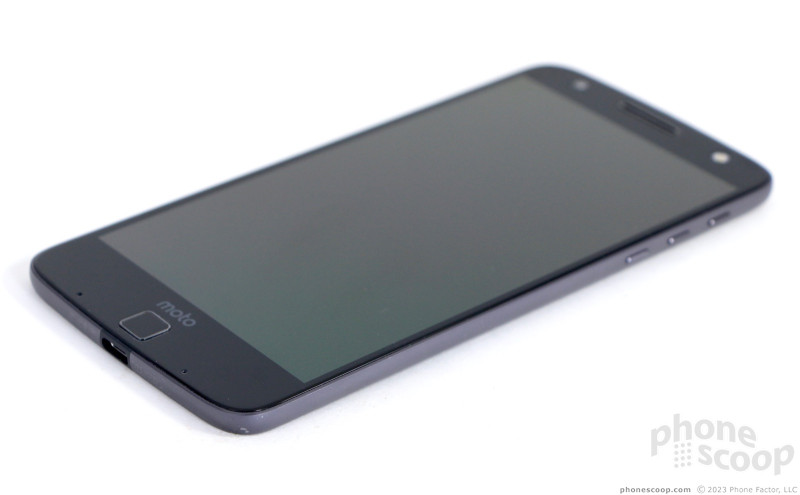


















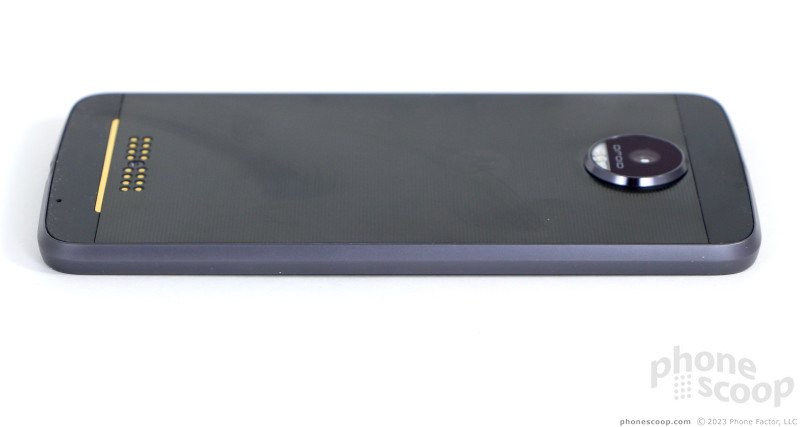






 Hands On With Moto Z Droid and Z Droid Force
Hands On With Moto Z Droid and Z Droid Force
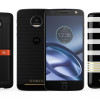 Motorola Debuts New Droid Zs with Swappable Back Modules
Motorola Debuts New Droid Zs with Swappable Back Modules
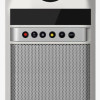 Motorola Announces Moto Mods Finalists
Motorola Announces Moto Mods Finalists
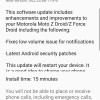 Verizon's Moto Z Droid Scores Security Update
Verizon's Moto Z Droid Scores Security Update
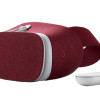 Google Improves the Selection of Daydream VR Apps
Google Improves the Selection of Daydream VR Apps
 Motorola Moto Z Droid
Motorola Moto Z Droid
 Motorola Moto Z Force Droid
Motorola Moto Z Force Droid





